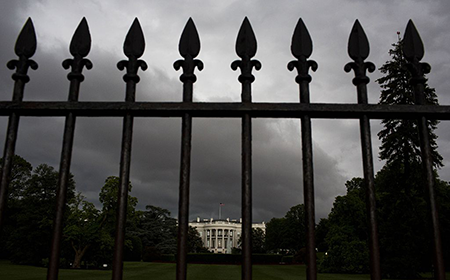"In my home there are few publications that we actually get hard copies of, but [Arms Control Today] is one and it's the only one my husband and I fight over who gets to read it first."
Nuclear Challenges Facing the Next U.S. President
December 2024
By Daryl G. Kimball
Global nuclear dangers are growing, and international peace and security are at severe risk. In January, the second presidential administration of Donald Trump will be tasked with managing a complex array of nuclear weapons-related dangers, some of which were partly of his own making and all of which will be difficult to address. Trump’s proposed solutions to these challenges were hardly explained, let alone debated, during the 2024 campaign cycle.

The war in Ukraine and the risk of escalation. Perhaps the most critical foreign policy variable will be whether and how Trump pursues his ambitious goal to impose a deal that halts the ongoing war being waged by Russian President Vladimir Putin against Ukraine but would lead to major territorial concessions to Russia. A ceasefire likely will not come swiftly, and if it does, it will shape very profoundly the European security environment for years to come.
As Putin pushes to gain additional territory ahead of any talks, he may try to employ new or more lethal weaponry and use nuclear coercion to try to gain some advantage. Trump, as U.S. President Joe Biden, should refrain from issuing nuclear threats of his own and instead join other global leaders to condemn threats of nuclear first use as inadmissible.
Heading off a three-way nuclear arms race. All major nuclear-weapon states are spending tens of billions of dollars modernizing their nuclear arsenals. Talks on nuclear arms control remain stalled. With the last remaining agreement limiting the Russian and U.S. arsenals due to expire in February 2026, an era of unconstrained nuclear competition looms.
In response, congressional Republicans and the authors of the Project 2025 plan want Washington to spend even more than the current $756 billion, ten-year price tag for nuclear modernization in order to increase the number and diversity of the arsenal. Such a buildup would reverse 35 years of Russian-U.S. reductions, is not necessary to deter nuclear attack, would divert resources from other defense and human needs, and would prompt China and Russia to match any U.S. increase.
Trump and his team have not offered a plan for constraining Russia’s strategic arsenal, and some Republicans may lobby Trump to withdraw from the New Strategic Arms Reduction Treaty.
Instead, Trump could try to achieve what Biden could not: a simple, informal deal with Putin pledging each side to maintain the existing caps on their strategic nuclear arsenals as long as the other does. This would allow the U.S. nuclear enterprise to focus on maintaining the existing force, buy time for formal talks to limit strategic, intermediate, and tactical nuclear weapons and the systems that carry them, and forestall a costly arms race that no one can win.
Maintaining the global test ban. No state except North Korea has conducted a nuclear test explosion in this century, the United States has not tested since 1992, and the world is more stable as a result. For the United States, nuclear explosive testing is technically and militarily unnecessary. A generously funded and proven Stockpile Stewardship Program maintains the existing U.S. warhead types.
Nevertheless, Trump’s former National Security Advisor Robert O’Brien proposed a resumption of U.S. nuclear testing in Nevada, which would violate the 1996 Comprehensive Test Ban Treaty. Project 2025 calls for reducing the time necessary to resume nuclear testing to six months or less. Any such move would be a self-inflicted nuclear policy disaster that would open the door to Chinese, North Korean, and Russian testing and blow apart global nonproliferation efforts at a time of heightened nuclear danger.
Stopping a nuclear-armed Iran. Since Trump withdrew from the successful 2015 Iran nuclear deal, Tehran’s leaders have restored their capacity to produce weapons-grade nuclear material and reduced access to international inspectors who are needed to guard against nuclear breakout.
Iran’s new president has offered to engage in talks that could lead to action-for-action steps to deescalate tensions, which could help move Iran further away from the nuclear threshold. But most advisers in Trump’s circle want to double down on the failed "maximum pressure" sanctions policy of Trump’s first term to force Iran to back down or help Israel try to destroy parts of Iran’s nuclear infrastructure.
Such action would make Iran’s acquisition of the bomb in the future far more likely. Last month, Iran’s deputy foreign minister said Tehran would withdraw from the nuclear Nonproliferation Treaty if the United States and others sought to snap back international sanctions through the UN Security Council before October 2025. Iran’s nuclear knowledge cannot be bombed away. Any setback in its nuclear infrastructure would be temporary and likely lead Iran to pursue a clandestine bomb program.
The risk of nuclear war, nuclear arms racing, and nuclear proliferation is already greater than at any point since the Cold War. In the months ahead, the new Trump administration will make key choices that could determine whether the situation improves or deteriorates. It will be essential that responsible members of Congress, responsible Western and non-nuclear-weapon states, and civil society campaigners help steer toward a safer course.
